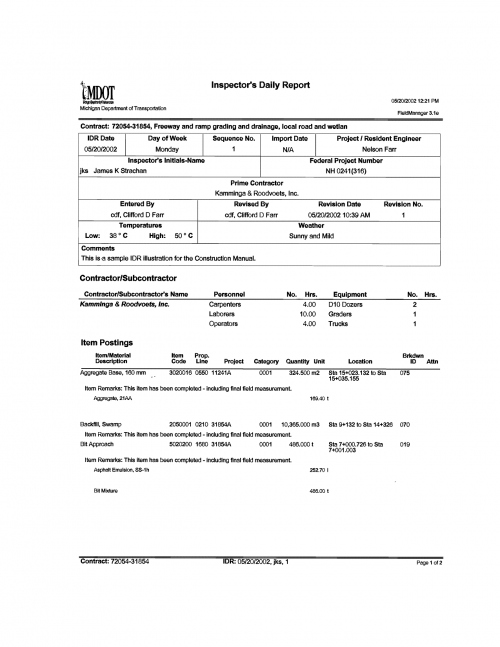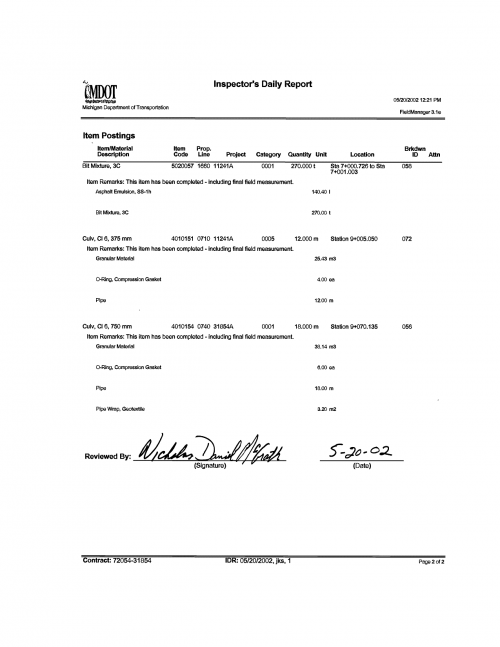Difference between revisions of "FieldManager"
| Line 38: | Line 38: | ||
===[[#Inspector's Daily Report (IDR)|Inspector's Daily Report (IDR)]]=== | ===[[#Inspector's Daily Report (IDR)|Inspector's Daily Report (IDR)]]=== | ||
| − | Perhaps the single most important type of project documentation is the Inspector’s Daily Report (IDR) and its variations. | + | Perhaps the single most important type of project documentation is the Inspector’s Daily Report (IDR) and its variations. Because of the IDR’s importance, it is imperative that it be prepared correctly, legibly and thoroughly. At the very minimum, a completed IDR must include all report header information, a statement in the body of the report and a signature of the person who reviewed the IDR. The person reviewing the IDR should not be the author of the IDR. |
| − | The exact nomenclature and pay item code number shown in the proposal must be used when turning in a pay item. | + | The exact nomenclature and pay item code number shown in the proposal must be used when turning in a pay item. Any inaccuracy in nomenclature or code can be misleading, as many contracts contain pay items with similar nomenclature. |
| − | The recommended work flow method for submitting automated | + | The recommended work flow method for submitting automated or manual IDR’s to the office for processing is to have each individual inspector complete the IDR and submit it to the office for processing. |
| − | Regardless of the method used, it is always the senior technician’s responsibility to collect all reports daily, review them and turn them into the office technician. | + | Regardless of the method used, it is always the senior technician’s responsibility to collect all reports daily, review them and turn them into the office technician. Either the senior technician or the office technician checks and initials all computations. |
| − | Inspectors should complete and submit reports no later than the first work day after the work was performed. | + | Inspectors should complete and submit reports no later than the first work day after the work was performed. The sooner information is put in writing, the more accurate it will be. |
| − | In addition to the pay items, other details to be documented in the body of the report include Subcontractor information, final pay item quantities, final pay item field measurement (these items should be clearly labeled as final measured), associated pay item test material usage and comments, comments on maintaining traffic and maintenance of traffic devices (traffic device checks must be recorded daily). Comments on attitude and quality of Contractor’s work may also be recorded. | + | In addition to the pay items, other details to be documented in the body of the report include Subcontractor information, final pay item quantities, final pay item field measurement (these items should be clearly labeled as final measured), associated pay item test material usage and comments, comments on maintaining traffic and maintenance of traffic devices (traffic device checks must be recorded daily). Anytime a material is posted to a pay item on an IDR, the inspector on site needs to visually inspect, verify the source/product name of the material, and document the information on the IDR. If the material source is unavailable, indicate that on the material posting. Comments on attitude and quality of Contractor’s work may also be recorded. |
| − | Other details that should be recorded include complaints from the public, along with inspector responses to these complaints, unusual events, daily weather conditions and accidents. | + | Other details that should be recorded include complaints from the public, along with inspector responses to these complaints, unusual events, daily weather conditions and accidents. Exceptionally good or bad work may also be cited. |
Questions regarding this process can be answered by calling the FieldManager Help Line at 517-322-1556. | Questions regarding this process can be answered by calling the FieldManager Help Line at 517-322-1556. | ||
Revision as of 11:02, 21 August 2014
FieldManager
FieldManager is a construction management system employed by over 1000 users to manage and track road and bridge construction projects in Michigan. It will be used by MDOT’s Region, TSC and construction field offices, local government agencies and construction consultants. Business functions automated by FieldManager include the following.
- Contractor payments
- Inspector’s Daily Reports (IDR)
- Daily Diaries
- Work item progress
- Contract Modifications
- Material usage
- Stockpile management
- Estimates
- Project finalizations
Construction projects are initialized in FieldManager from files that have been created in Lansing using AASHTO’s Trns*port software. Once construction begins, FieldManager stringently monitors and reviews the work activities that occur throughout the life of each project. IDR information is captured on notebook computers directly at the construction sites and later transferred to a network, or desktop computer, located in the field office responsible for managing the project. More than 50 inquires are available to provide information when and where it is needed. FieldManager also sends pertinent data to Trns*port software on a daily basis.
The FieldManager suite of products consists of four components:
- FieldManager - The main component, which usually runs at the field office and manages product data by processing IDR’s, Contract Modifications and Estimates.
- FieldBook - Used to gather IDR information directly at the construction site and sends the IDR’s electronically to FieldManager.
- FieldPad - A subcomponent of FieldBook that runs on a hand held device.
- FieldBuilder - Allows local government and consulting agencies to establish their own respective FieldManager projects on contracts that will not be processed through the Trns*port system.
For information on acquiring the software, self-paced FieldManager and FieldBook Tutorials, FieldManager User’s Guide, Trns*port interface or technical questions, please call the FieldManager Help Line at 517-322-1556.
Current information on FieldManager system requirements, articles, press releases, events, presentations, license feed, etc., can be found at www.fieldmanager.com
Inspector's Daily Report (IDR)
Perhaps the single most important type of project documentation is the Inspector’s Daily Report (IDR) and its variations. Because of the IDR’s importance, it is imperative that it be prepared correctly, legibly and thoroughly. At the very minimum, a completed IDR must include all report header information, a statement in the body of the report and a signature of the person who reviewed the IDR. The person reviewing the IDR should not be the author of the IDR.
The exact nomenclature and pay item code number shown in the proposal must be used when turning in a pay item. Any inaccuracy in nomenclature or code can be misleading, as many contracts contain pay items with similar nomenclature.
The recommended work flow method for submitting automated or manual IDR’s to the office for processing is to have each individual inspector complete the IDR and submit it to the office for processing.
Regardless of the method used, it is always the senior technician’s responsibility to collect all reports daily, review them and turn them into the office technician. Either the senior technician or the office technician checks and initials all computations.
Inspectors should complete and submit reports no later than the first work day after the work was performed. The sooner information is put in writing, the more accurate it will be.
In addition to the pay items, other details to be documented in the body of the report include Subcontractor information, final pay item quantities, final pay item field measurement (these items should be clearly labeled as final measured), associated pay item test material usage and comments, comments on maintaining traffic and maintenance of traffic devices (traffic device checks must be recorded daily). Anytime a material is posted to a pay item on an IDR, the inspector on site needs to visually inspect, verify the source/product name of the material, and document the information on the IDR. If the material source is unavailable, indicate that on the material posting. Comments on attitude and quality of Contractor’s work may also be recorded.
Other details that should be recorded include complaints from the public, along with inspector responses to these complaints, unusual events, daily weather conditions and accidents. Exceptionally good or bad work may also be cited.
Questions regarding this process can be answered by calling the FieldManager Help Line at 517-322-1556.
A sample IDR is shown in Figure 101-1.
Using FieldManager to Track Design-Build Contracts
The purpose of this section is to provide instructions on how to utilize FieldManager to track design-build contracts. When design-build contracts are awarded, the managing office will receive the FieldManager initialization file (live contract) through FieldNet, which contains three-to-five pay items used to pay the contractor. However, design-build contracts do not use typical construction work items; therefore, FieldManager will utilize two contracts. In addition to the “live contract,” the managing office will also use a “shadow contract”, which will be used to:
- Document construction activities
- Document work items
- Track material usage and approvals
In short, continue using MDOT procedures when documenting the above items in the shadow contracts.
It is critical to track and document material usage on design-build contracts. Book 2 section 2 of
design-build contracts require the design-build team to provide MDOT with the estimated quantities for all items that require inspection or testing in accordance with MDOT’s Material Source Guide. The team must submit this information with or before the “released for construction” documents. The managing office will manually enter this information into the shadow contract.
FieldNet will be used for the live contract pay estimates, contract modifications, and contractor performance evaluations; however, FieldNet will not be used to process these electronic files for shadow contracts.
Documenting Procedures for Live and Shadow Contracts
- When the initialization file is received through FieldNet, contact the FieldManager Help Desk to acquire a shadow contract initialization file.
- Use the following contract ID naming convention:
- Live contract: 38103-105785
- Shadow contract: _38103-105785X
- Use the following project number naming convention:
- Live contract: 105785A
- Shadow contract: _105785AX
- Adding shadow contract items and materials:
a. Add items through:
- Contract modifications, or
- Tracked as unattached items
b. Add materials associated with items as needed.
- Subcontracts – Enter subcontracts into the live contract and the shadow contract; this includes the design subcontract.
- Construction Started Date – Populate the FieldManager Docu > General tab > “Construction started date” is to be populated when the design starts (just after award) on the live and shadow contracts, as the designer is a subcontractor.
- Contract Files – Include shadow contract documents in the original live contract files.
- Contractor Performance Evaluations (CPE) – Shadow contract CPEs will not be used for official contract documentation, but they must be generated before FieldManager will allow a final estimate to be completed. Use N/A to fill out the ratings tab for shadow contract CPEs.
- Archiving Shadow Contracts – Archive the contract in FieldManager after completing the final estimate, as is required with the live contract.
- FieldNet – You can use FieldNet to transfer shadow contract files between FieldManager and FieldBook, as can be done with any live contract. Contact the FieldManager Help Desk should you wish to use this feature.
- Contractor Read-Only (CRO) Files – In most cases, managing offices will not be creating biweekly shadow contract estimates. Therefore, contractors will not automatically receive CRO files as estimate creation is the auto-send CRO trigger. Users can still send CRO files to contractors via FieldNet by using FieldManager’s File > Export > Transfer contracts functionality.
- Stockpiles – This feature can be used on shadow contracts depending on how the managing office chooses to track contractor progress within the shadow contract.
To request a shadow contract or FieldManager support for design-build contracts, please contact the FieldManager Help Desk at 517-322-1556.

